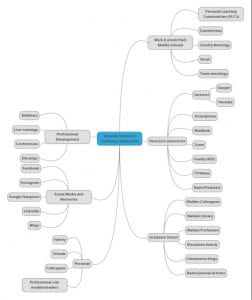From behaviorism to social learning and everything else in between, people have been trying to understand how people learn for at least 2000 years. The topic of the mind and learning seems to date back to Ancient Greece. Throughout the centuries, many have tried to explain the human mind and how it works. However, in the nineteenth century, advancements in science and technology finally allowed psychologists to gain a better understanding of the human mind, beginning with behaviorism. As society and our world continue to evolve, as well as continued advancements in the field of science and technology, more and more learning theories have gained momentum.
Throughout this course, learning theories have been the focal point of many assignments and discussions. As a teacher in the field of education for fifteen years, learning theories have been ingrained into my teaching philosophy. Through learning about the brain itself and how it works (Ormrod, Schunk & Gredler, 2009), I have gained a better understanding of cognitivism. What I thought was particularly interesting in this course, was reading about and participating in a debate over whether or not neuroscience should influence education. I understand both sides of the argument. Another great opportunity with the course was being able to complete the learning matrix that detailed each learning theory. Through that experience, I found myself comfortable with several learning theories and not just one. Looking back at Kapp’s (2007) blog post, I agree with Kapp on how he was trying to validate that no one learning theory can be all encompassing to explain the human brain and its processes. It is, rather, a collection of the -isms that comprise the workings of information processing and the behaviors that follow. This was eye opening, because as a teacher and lifelong learner, I have felt that I utilize many tenets of several learning theories in both my personal learning career and my professional teaching career. Overall, I learned that having a theory or model is an important prerequisite for quality curriculum design. Henson (2015) referred to a model like painting or a story, which is either written or visually represented, that describes one’s perception of reality.
Over the past few weeks, I was able to look inward and identify a learning challenge of my own. Through this process I learned a challenge I have with encoding, which is one of the three main cognitive processes (Ormrod in Laureate Education, n.d.). It was interesting to take in the experience of admitting a flaw in my own learning process. I think it helped me become a better educator because I am able to consider my own challenges when looking at the challenges my students may be facing. Another takeaway from this course was exploring and studying adult learning. According to Conlan, Grabowski, and Smith (2003), there are five assumptions that compose the basis of adult learning: the individual must be able to self-direct their learning; the individual must have an abundance of life experiences that provide a bedrock for new learning, in individual must have learning goals and needs that are tied to social roles; the individual is interested in applying the knowledge and skills obtained; and the the individual is motivated to learn on their own accord. Since this is my second online masters program, the tenets of adult learning made a lot of sense to me. Overall, I learned that learning is both similar and different in youths and adults.
Finally, I have found that technology plays an integral role in the learning we participate in today in the 21st century. Technology can be used with each learning theory that we studied in this course. From using technology to monitor behaviors (behaviorism) to using technology to learn from each other socially. Technology has a role in learning and it is here to stay. What fascinates me most about technology and learning is that technology can enable students to learn at their own pace. Additionally, technology can help teachers reach students to meet their needs in new and different ways like never before. According to Waddell (2015), technology has been used to help improve and facilitate learning experiences that allow both student and teacher to gather, access, analyze, present, and transmit information quickly and efficiently.
In closing, learning theories are well researched and well understood. The world is constantly changing, and thus humans are changing as well. As the human mind evolves to meet the demands of the new world in front of us, new and different learning theories will emerge just the way they have done in the past. It surely is an exciting time to study the mind and human development.
References
Henson, K.T. (2015). Curriculum planning: Integrating multiculturalism, constructivism, and
education reform (5th ed.). Long Grove, IL: Waveland Press
Kapp, K. (2007). Out and about: Discussion on educational schools of thought. Retrieved from https://karlkapp.com/out-and-about-discussion-on-educational/
Laureate Education (Producer). (n.d.b.). Information processing and problem solving [Video file]. Baltimore, MD: Author.
Ormrod, J., Schunk, D., & Gredler, M. (2009). Learning theories and instruction (Laureate custom edition). New York, NY: Pearson.
Waddell, J. (2015). The role of technology in the educational process. Michigan State University College of Education. Retrieved from https://education.msu.edu/green-and-write/2015/the-role-of-technology-in-the-educational-process/.
